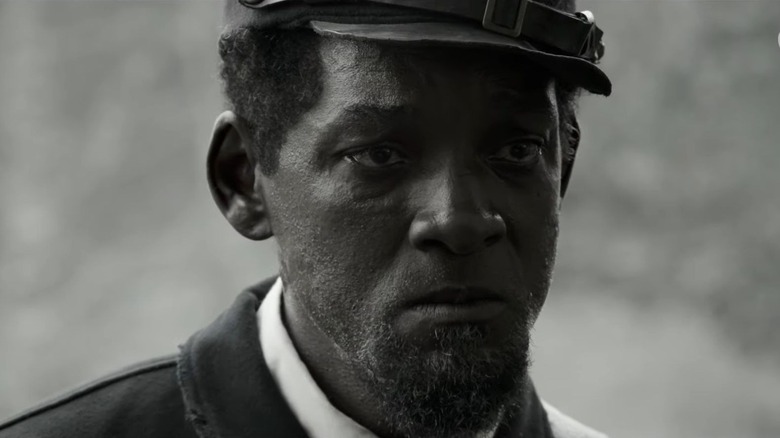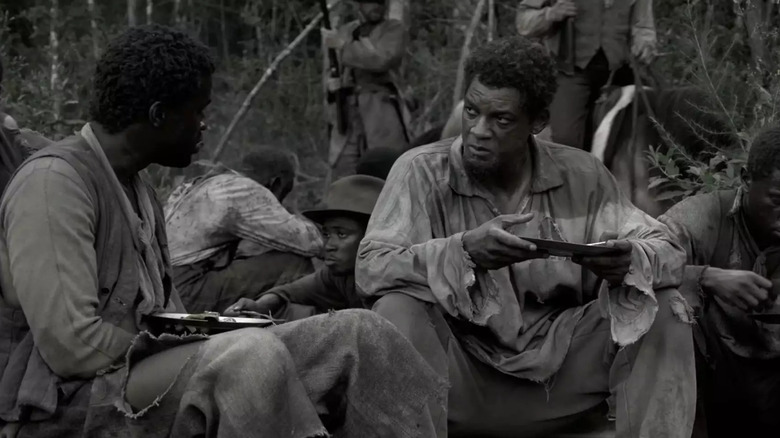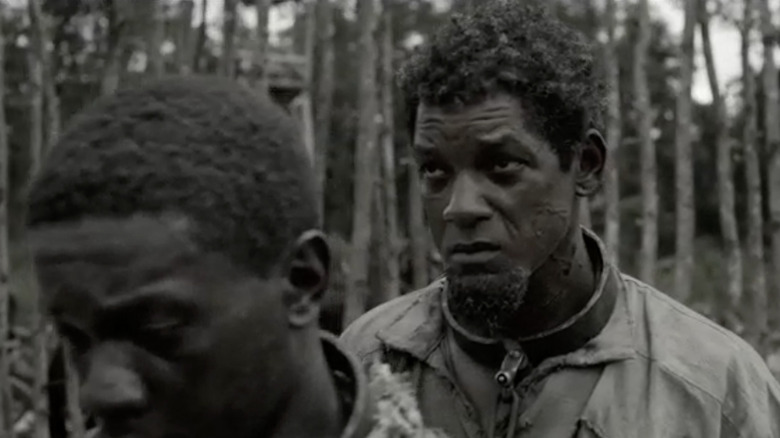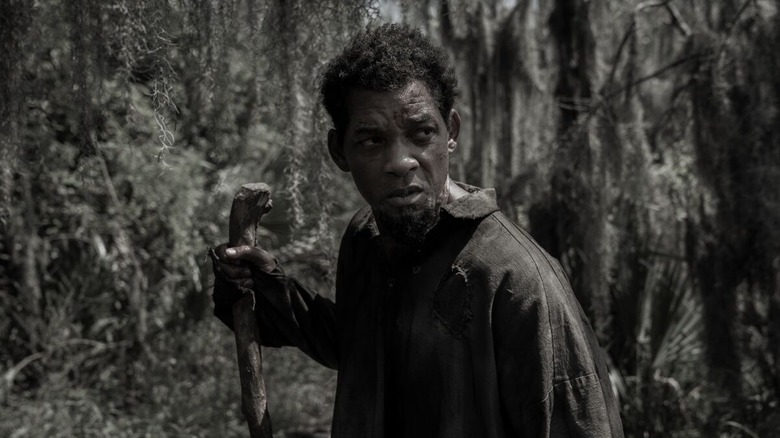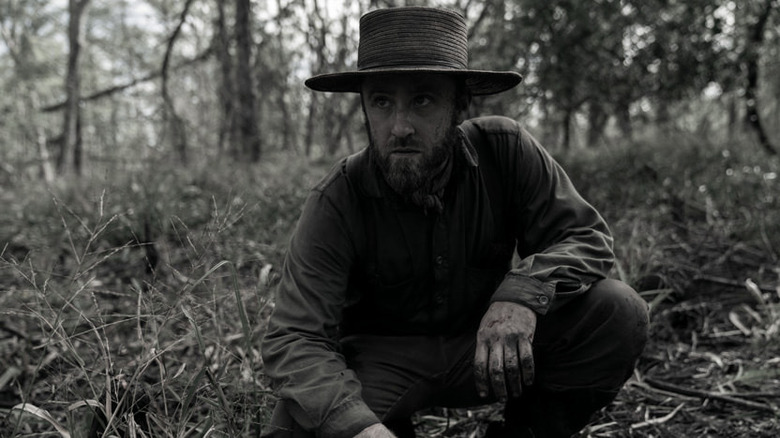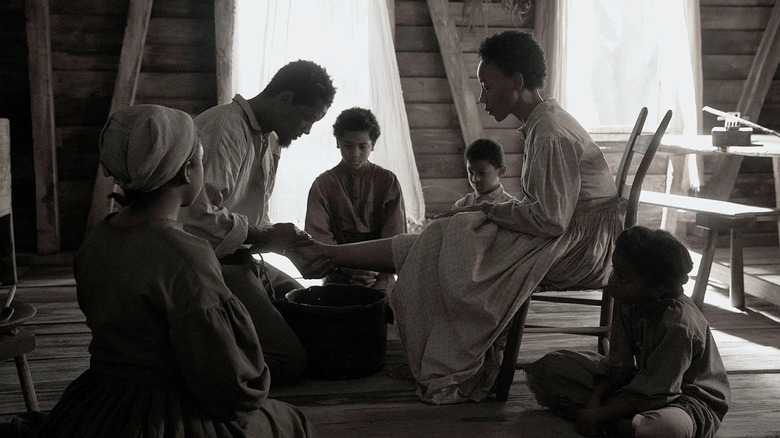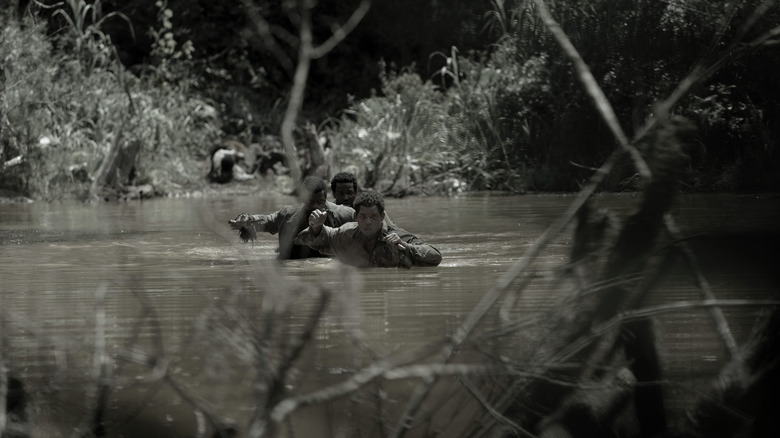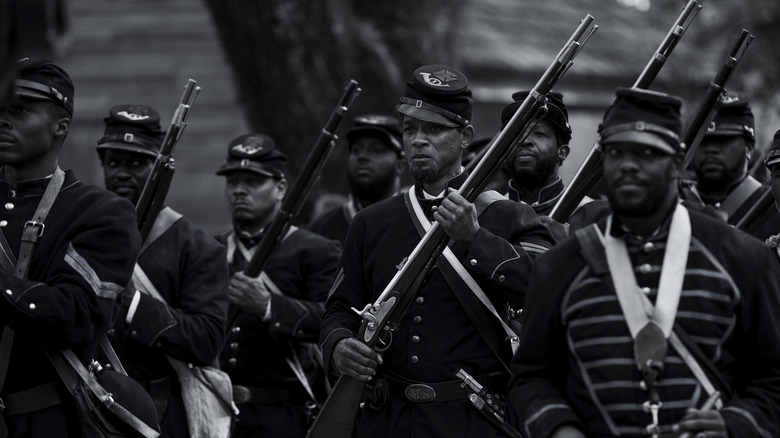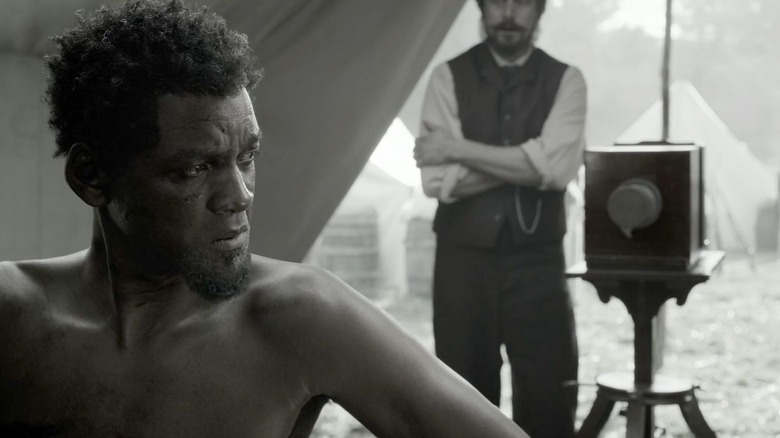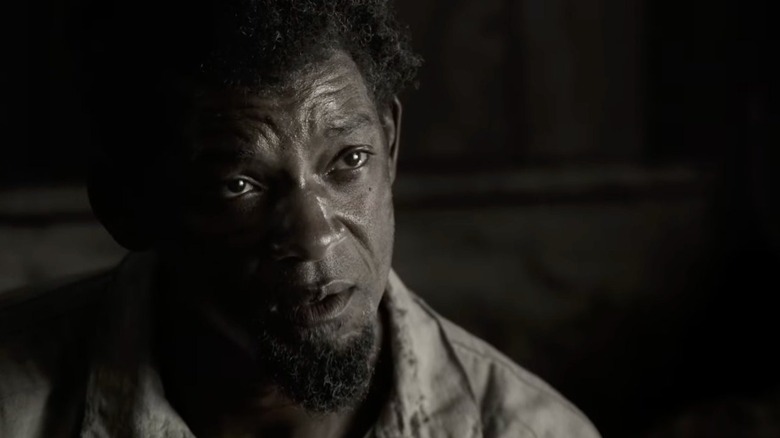The Ending Of Emancipation Explained
Contains spoilers for "Emancipation."
Will Smith and director Antoine Fuqua both have skill sets that translate easily into awards-caliber dramas ("Ali," "Training Day") as well as spectacle-heavy blockbusters ("Independence Day," "Olympus Has Fallen"). Their latest collaboration, "Emancipation" (streaming now on Apple TV+), splits the difference. Like "The Revenant" and "Django Unchained" before it, "Emancipation" combines grave subject matter with gorgeous cinematography and gut-wrenchingly violent action sequences. This is a film that lingers on Smith's face as he tries to process the unfathomable inhumanity with which he's treated, but it's also a movie in which he wrestles an alligator and stabs people with a cross. Though Fuqua goes big in the marquee set pieces and doesn't try to mask his overall intent, parts of "Emancipation" are more subtle and require further explanation.
Set in the tense time period between President Lincoln's Emancipation Proclamation and the end of the American Civil War, the film centers itself almost entirely on a real person from history. But, since we don't know all that much about the character Smith portrays (the movie names him Peter), filmmakers have taken liberties both for the sake of the narrative and to fill in spots where there isn't verifiable truth. Broadly speaking, the reality presented in "Emancipation" was the reality of enslaved people from 1863 through 1865, even if the events depicted are largely manufactured. This is what becomes of Peter and how he's rooted in a pivotal moment in history.
Peter and Gordon
Early on in "Emancipation," Peter makes the acquaintance of another enslaved man named Gordon. He takes him under his wing and tries to keep his spirits up despite the living nightmare they find themselves in. Later, after Peter arrives in Baton Rouge, he's elated to reunite with Gordon, who's wounded on a stretcher but alive. This minor character was likely added as an acknowledgment on the part of filmmakers that we can't be sure about the identity of the man Smith is portraying ... the man pictured in what would become the world-famous photograph recreated near the end of the movie. Reliable sources still disagree about who he really was.
Some believe his name was Gordon but that slavers and even sympathetic publishers were so calloused toward him, the detail of his given name wasn't important enough to get right (via the Sojourner Truth African Heritage Museum). Others believe the man whose photographs were widely circulated at the time was actually two different people, one named Gordon and one named Peter (via American Nineteenth Century History). The most well-known version of the picture was printed in Harper's Weekly in July 1863, along with two other images of a man, said to be the same person, labeled "Gordon as he entered our lives" and "Gordon in his uniform as a U.S. soldier." Another copy of the center image, housed at the National Archives, contains an inscription and is attributed to a man named Peter, who also gave an account of his ordeal. It's possible but not definite the clothed man is Gordon (he appears younger and has different facial hair), while the man with the back scars is Peter, and that sloppy journalism took place in a rush to publish the story.
Peter seizes his opportunity
"Emancipation" begins when Peter is forcibly separated from his family, shackled, and taken from Senator John Lyons' (Timothy Hutton) plantation to work on the railroad. But it kicks into high gear when he makes his daring escape. While the treatment of Black slaves on the plantation is horrific, railroad work is all but a death sentence. Men are branded on the face for trying to run away. They're shot on sight if they're unable to carry the load. And as an extra warning to obey, severed heads on spikes line the road.
Peter eavesdrops on the overseers' conversation and learns that if he makes it to the Union camp at Baton Rouge, he'll be free. This gives Peter the motivation to make a move, but not the opportunity. That comes when he's asked to dispose of a dead body. He carries the corpse to a mass grave, the smell of which is being mitigated with lye. When a white worker refuses to do the job with enslaved Black men around, Peter is given the shovel. He realizes that one against two, with a weapon in his hand, might be the best odds he'll ever get. Peter flings hot ash in his tormentors' faces, then incapacitates (and probably kills) them with the shovel. He makes a run for it, with three of his fellow enslaved men in tow. On his tail is the most formidable overseer, Jim Fassel (Ben Foster), and his vicious dogs, who have locked onto Peter's scent.
His faith and intelligence help him persevere
Peter's harrowing trek though miles of dense and dangerous swampland comprises most of "Emancipation." Throughout his journey from Clinton to Baton Rouge, we see the highly observant and resourceful Peter take several unusual actions that save his life. He watches the skies: The direction in which flocks of birds fly helps him to ascertain the location of the Union cannons ahead and the barking pack of dogs behind him. He stashes a bloody rag that he'd used as a tourniquet on his leg wound to throw off the hounds. But perhaps his cleverest trick is masking his human odor with the smell of raw onions.
If they are to be relied upon, reports of Peter's ordeal (like the one published in Harper's Weekly) claim that he did, in fact, rub himself with onions that he'd taken from the plantation and kept in his pocket. He knew they'd make it harder for bloodhounds to track him, so every time he emerged from the water (which also helped to keep the dogs at bay) he'd reapply a fresh layer of onion. While the real Peter may have survived because he knew the swamps like the back of his hand, the movie version also finds strength and solace in his Christian faith. While it's certainly possible that Peter was a religious man, there's no evidence for this in the historical record. His faith appears to be an element added by Smith and the filmmakers to explain Peter's ability to endure and remain hopeful, even in the most hellish of circumstances.
Fassel reflects on a traumatic experience
The villain in "Emancipation" is Jim Fassel, a steely and methodical overseer and slave hunter who relentlessly tracks Peter. While plantation and slave owner John Lyons was a real person, according to 1860 census data, Fassel is a composite character, meant to represent the kind of hired hands who enforced the violent practice of slavery. Most of the white southerners exploiting Black slaves in this film are shown to harbor a certain kind of prejudice. The conventional wisdom is that racists of the time thought Black enslaved people to be less-than-human, and the casual racism found even in documents from the pro-abolition North supports this. Jim Fassel's monologue exposes an even more insidious kind of bigotry.
Fassel recalls a childhood memory to his underlings when one of them expresses surprise at Peter's skill. He tells them his mother died when he was young, leaving him to be raised by a loving, capable enslaved woman with whom he became very close. When he asked if they could eat dinner together, his father asked, "What then?" and refused. Fassel explains that his old man taught him that if they extended any kindness to enslaved Blacks — so much as a crumb — eventually, they'd turn the tables, overtake the country, and pay back their captors in kind. Then he killed the woman, though it took her three days to die. This incident hardened Fassel, who came to believe in the subjugation of Blacks — who he does view as his equals, albeit in a disturbing way — as a protective measure.
Peter's family holds on
"Emancipation" takes the most creative license with its depiction of Peter's family. He's desperate to get back to his wife, Dodienne, and their four children. Peter and Dodienne's deep and abiding love helps them both endure a lifetime of oppression with their mental health relatively intact until they're finally free. Sadly, In real life, Peter's marriage and sanity didn't make for such an inspirational story. He claimed that he was married while he was enslaved at the Lyons' plantation. We don't know whether he and his wife had children. All Peter mentions of his domestic life is that he had memory trouble, had gone "sort of crazy," and "attempted to shoot everyone," including his wife (via History Link 101). In retrospect, Peter may have been suffering from PTSD or some sort of traumatic brain injury after the beatings that left him comatose.
There is some truth to Dodienne and her children's fictionalized subplot. Fuqua uses it to illustrate specific tactics families used to stay together and as safe as possible. In the opening scene, Peter is tenderly washing Dodienne's feet. He later mentions that overseers regularly burned his feet as punishment, which implies Peter was tending to his wife's burns. When she learns that she's being sold, the overseer comments that her daughter is almost as tall as she is, a not-so-subtle indication of her sexual maturity and a reflection of the fact that many enslaved women — including girls — were victims of sexual violence. This is why enslaved people like Dodienne sometimes took the risk of harming themselves in hopes that their decreased value as a worker would keep them from being sold.
He makes it to Baton Rouge
The most accurate part of "Emancipation" is the time and distance it took Peter to escape to the Union military encampment. His testimony to medical examiners, later printed in the press, stated that it took him 10 days to reach Baton Rouge. In total, with hunters and dogs in pursuit, Peter traversed somewhere between 40 and 80 miles of treacherous swamp which would've looked almost exactly like the landscapes shown in the film. "Emancipation" was shot on location in Louisiana (via Variety). Fuqua and cinematographer Robert Richardson decided to desaturate the images as near to complete grayscale as possible, while adding back in some of the green of the swamp, so as to convey the harshness of the natural atmosphere without any of the beauty or sentimentality.
However, two of the most climactic moments in the movie didn't happen. A Jim Fassel-like figure didn't catch up to Peter just before the Union line (though he was captured by Confederate soldiers once he enlisted). And there's no record of Peter ever fighting off an alligator. Gators are common in the area, and it's plausible that he would've encountered many on his way, but had he defeated one in close combat with a stick and a knife, the incident would've surely made it into Peter's interview with photographers at the base camp. This over-the-top scene was probably included to show the dangers along Peter's route and to break up the monotony of ten long days of walking.
The northerners give him a choice
When Peter arrives at the Union camp in Baton Rouge, starving, thirsty, and with his leg infected, he's given a bed in a makeshift hospital. He's desperate to reunite with his family, but a conscription officer matter-of-factly informs him that's not an option. The Emancipation Proclamation freed the slaves from the North's perspective, but the Union is still at war with the Confederacy, which means technically, they're harboring a fugitive. Peter doesn't really have true freedom yet. He has two choices: He can go North and work on a farm, or he can enlist and fight. It's an easy decision. Peter has no interest in working the land, but he has the will to go to war and gather inside information that can help the cause.
Still, even among the men who seek to eradicate slavery, Peter encounters racism. A general (David Denman) sees the photo of his scars and wonders if he might be too disobedient for service. This attitude is reflected in the news of the time. The real Peter (or Gordon) willingly joined in the war effort, first as a guide, then as a Sergeant in an all-Black unit. But white people continued to question his intellect and temperament, if not his bravery. A surgeon wrote of Peter, "...on the contrary, he seems INTELLIGENT AND WELL-BEHAVED," as if this was shocking.
His condition is captured in a photograph
The inspiration for "Emancipation" is that photograph that came to be called "scourged back" or "Whipped Peter." In the film, after Peter's healed enough to enlist and is waiting in line for his uniform, two military doctors, McPherson and Oliver, approach and ask him about his "condition." By condition, they mean the many keloid scars on his back, put there from butcherous beatings. A nervous and suspicious Peter poses for the picture that will go viral by 19th-century standards, though the movie doesn't show its impact.
In real life, Peter arrived in Baton Rouge in March 1883. McPherson and Oliver took that photograph the following month. Almost immediately, it began to circulate privately and publicly among abolitionists, who realized the startling image could be used to communicate the horrors of slavery to a wider audience, as well as to fundraise. "This Card Photograph should be multiplied by 100,000, and scattered over the States," an unnamed journalist wrote of "scourged back." On July 4th, 1863, Harper's Weekly did just that with its trio of images (illustrations etched from the original photograph) and accompanying article. The medium itself had only recently been invented, and the advent of photorealistic images not only helped the public to understand the violence inflicted upon enslaved people, but the violent reality of the Civil War ... the first major military conflict to be captured with a camera.
He's a catalyst for justice
"Emancipation" concludes as Louisiana's enslaved people are freed, and Peter's former master, John Lyons, is executed. After months apart, Peter finds his family in the chaos, and they cry and laugh as they embrace each other. Title cards tell us that, "Peter's image traveled around the world many times over," and that, "he became the rallying cry against slavery." They also remind us that more than 400,000 enslaved men and women escaped from bondage prior to the end of the war (many of whom bore similar scars), at which time another 4 million were recognized as free citizens of the United States.
We don't know what became of John Lyons. In 1860, he owned 37 slaves, but today, his plantation no longer exists and there's no record of its demise. One possible answer is that the Union may have seized some of his land and fortune, but economic life for Southern slave owners in the post-Civil War era wasn't actually all that rough (via Washington Post). Peter, who didn't know how old he was, lived until July 20, 1907, well into old age. Even with all the holes in his scant biography, Peter's legacy is enormous. His photo was published at a low point for the Union, after military losses had dampened morale. Many Northerners were apathetic about slavery because they weren't exposed to it. And many Americans didn't believe such cruelty really occurred. Though some Confederates doubted their authenticity, the picture proof disavowed people of their ignorance and ambivalence, quickly building support for abolition at a crucial moment.
